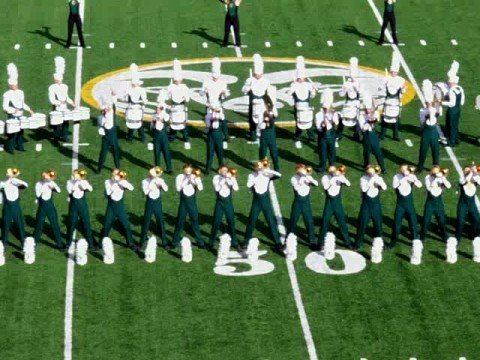 | ||
Similar Christopher Bill, Bob McChesney, Trombone Shorty, Jonathan Arons, The Ohio State University | ||
Dubstep trombone suicide
Trombone suicide is a type of marching band choreography, involving a line of trombone players in close proximity alternating horn positions. Players typically stand almost shoulder to shoulder, and take turns bending over from the waist or squatting, while standing players turn to the side with their instruments in the former headspace of the neighbouring player. The band's drumline keeps rhythmic cadence throughout.
Contents
- Dubstep trombone suicide
- Northwood high school marching band trombone suicide 1
- Choreography
- Variations
- Performers
- References
Risk of collision and injury is the likely reason for manoeuvre's colourful name. Learning and practice may result in "bloody noses, broken noses and hospital trips". The skirting of danger by players and their instruments, as well as the show of dexterity, may also generate cheers and positive feedback from the crowd. This choreography is sometimes referred to as doing "headchoppers", a playful allusion to the trombone motions directed at players' heads; additionally the entire group of individuals doing the movements can also be referred to as headchoppers.
Northwood high school marching band trombone suicide 1
Choreography
Due to the sometimes rigorous physical nature of the choreography, the instruments may not be played during the suicide, instead being used as props. Actual playing may be intermittently interspersed with fast movements, although players may attempt to preserve the illusion that they are playing throughout by keeping their mouthpieces close to their mouths.
Trombone slides are sometimes locked or taped in place to prevent centrifugal force from flinging them out of the horn while a player is in motion.
"Shooting ducks", the term for angling the instrument upwards when turning to the side, is usually discouraged in favour of keeping trombones parallel with the ground, although it can be employed to compensate for significant height differences between players.
Using an F-attachment on a trombone may increase difficulty during trombone suicide because of the associated increased weight to the instrument; greater weight increases inertia and requires more force to stop and reverse at the speed required to avoid collision.
Variations
Other instruments, like marching baritones or trumpets, may also be included in the line. Trombone suicide may be performed by blindfolded players. It may be performed in 1/2 time or doubletime. Players may shuffle their position in the line, scatter, or do other foot and leg choreography interspersed with the classic up-down-right-left or up-down-left-right stationary movements.
Performers
A number of high school and college bands in the United States are known to or have been recorded performing trombone suicide, either occasionally or regularly:
